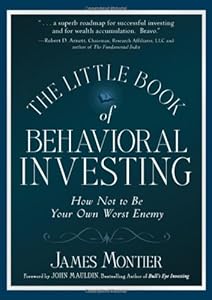We’re on to Chapter 13 of The Little Book of Behavioral Investing: How not to be your worst enemy and I thank you for your patience in sticking with my enterprise through the last 13 weeks. So… 13 weeks, 13th chapter, and I’m thinking, “13 … doom and despair, huh?” But then, Montier’s words quickly come to mind. Think back to Chapter 5 where he warns us against inadequate research and the folly of giving in to the noise.
So here’s what I did. My belief that the number 13 is associated with all things bad and dark … not that I’m superstitious but the thought is just there … is the remnant of old stories, propaganda, and yeah, some crazy horror flicks. So I checked it out and turns out I’m wrong. According to numerologists, the number 13 means upheaval but it has the power to enhance positive outcomes if change is adapted to gradually. Whad’ya know? Montier’s tips aren’t only helpful for investments!
But back to Chapter 13 and the point of discussion this time is about as challenging as it can get, especially for the modern Indian mindset. That’s my opinion by the way, not Montier’s. So, what would Montier have us learn in this chapter?
- Curb your action bias.
- Inculcate the quality of patience.
- Be at peace with doing nothing.
It seems shockingly simple but I can vouch a 100 percent that this is going to be an incredibly challenging practice for the investor community where so many suffer from the attention deficit hyperactivity disorder (ADHD).
In the modern world, doing nothing is interpreted as laggardness. While I don’t recommend you become a couch potato in physical terms, you need to be one if you’re a money manager, according to Seth Klarman. Why? Because you’re an investor, not a trader. And a good investor sells and buys only when the time and price is right. Remember the investment plan we discussed in Chapter 2 – prepare, plan, and pre-commit?
Sadly, not many money managers believe in this approach. And if they do, they can’t stick with it because their inaction would be interpreted as inefficiency by their managers and clients. They may also not want to upset the comfortable web they’ve spun for themselves via the prevalent money making mechanics.
People who are seen doing things (as in invested fully, selling and buying every so often) are perceived as more committed and efficient versus those who wait and watch. This perception becomes even more skewed if the investor has recently incurred a loss. While this unexciting investor may actually save dollars and build richer returns in the long run, not many people look beyond the short-term. And that, my dear friends, is the root of the problem.
It is also why I say that the learnings in this chapter may be specially challenging for the Indian mindset. All around, we see examples of short-term palliative measures. Governments use price controls to appease people even though it’s proven they have a detrimental effect in the long run. Government subsidies, free provisions, super low interest loans – sugared pills for vote banks – backlash over time to bite the same group of people. As individuals, we bribe, ignore, and submit to corruption because we’ve become habituated to quick solutions. Obviously, quick money solutions win the top spot for us.
The best investors of the world (and there are many Indians on this list) always look long-term. They are not driven into foolishness by an action bias of their own or external pressure because they’ve learned to be at peace with doing nothing. And the way they do this is by sticking with their investment plan.
To conclude: Get rid of the idea that investing is exciting. It’s not supposed to be. If you really want to make money, wait for the fat pitch. If that makes you the butt of criticism, remember that the road to your dreams is often lonely and rough. Think of all the greats!
Monica Samuel is doing a chapter-wise review of the book: The Little Book of Behavioral Investing: How not to be your worst enemy by James Montier. You can follow the series by following this tag: tlbbinvesting or by subscribing to this rss feed: tlbbifeed











